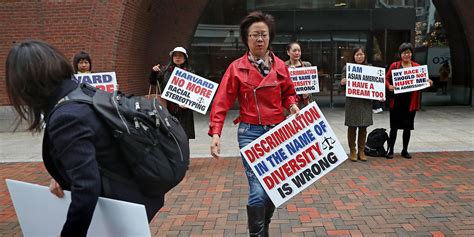
Universities are discriminating against White and Asian American applicants in their admissions processes, according to Vice President J.D. Vance, echoing claims that have fueled legal challenges to affirmative action policies.
Vice President J.D. Vance has publicly asserted that universities across the United States engage in discriminatory practices against White and Asian American applicants during the admissions process. Vance’s statements, made during a recent interview and reiterated through his social media channels, align with a broader conservative critique of affirmative action policies and their impact on the fairness and equity of higher education admissions. These assertions arrive in the wake of a Supreme Court decision that curtailed the use of race as a determining factor in college admissions, intensifying the debate over diversity, merit, and equal opportunity in higher education.
Vance’s remarks have drawn attention to the complex interplay between academic achievement, demographic representation, and institutional policies. The Vice President contends that the current admissions landscape, even after the Supreme Court’s ruling, still disadvantages certain racial groups. He suggests that universities continue to prioritize factors beyond academic merit that effectively limit the enrollment of White and Asian American students, despite their often high performance on standardized tests and in academic settings.
“I think a lot of these universities still discriminate against White and Asian applicants,” Vance stated in a recent interview. He elaborated that while explicit racial quotas may be prohibited, institutions have found other means to achieve desired diversity outcomes, such as emphasizing subjective criteria or giving preference to applicants from specific socioeconomic backgrounds or geographic locations.
The Vice President’s position reflects a growing sentiment among some conservatives who believe that affirmative action, even in its modified forms, has outlived its usefulness and now perpetuates a different form of discrimination. They argue that universities should adopt a strictly merit-based system where academic qualifications are the sole determinants of admission, regardless of race or ethnicity. This perspective is rooted in the belief that such a system would ensure equal opportunity for all applicants and lead to a more qualified student body.
However, critics of this view contend that a purely merit-based system would fail to address the historical and ongoing disadvantages faced by underrepresented minority groups. They argue that factors such as socioeconomic background, access to quality education, and systemic biases in standardized testing can significantly impact an applicant’s ability to demonstrate their full potential. Eliminating affirmative action altogether, they say, would exacerbate existing inequalities and lead to a less diverse and representative student body.
The debate over affirmative action and its impact on college admissions is likely to continue, with significant implications for the future of higher education and the pursuit of equal opportunity in America. Vance’s remarks have injected new energy into this debate, highlighting the deep divisions that persist over how to achieve fairness and diversity in higher education.
The Supreme Court’s Decision and Its Aftermath
The Supreme Court’s recent decision to strike down affirmative action policies in college admissions has reshaped the legal landscape of higher education. The ruling, which effectively prohibits the use of race as a determining factor in admissions, was hailed by conservatives as a victory for equal opportunity and criticized by liberals as a setback for diversity and inclusion.
The Court’s majority opinion argued that affirmative action policies, as they were previously implemented, violated the Equal Protection Clause of the Fourteenth Amendment. The justices contended that these policies unfairly discriminated against certain racial groups and perpetuated racial stereotypes.
In the wake of the ruling, many universities have been forced to reassess their admissions policies and procedures. Some institutions have pledged to find alternative ways to promote diversity, such as by increasing outreach to underrepresented communities, expanding financial aid programs, and emphasizing holistic review processes that consider a wide range of factors beyond academic merit.
However, the long-term impact of the Supreme Court’s decision remains uncertain. Some observers predict that it will lead to a significant decline in the enrollment of underrepresented minority students at selective colleges and universities. Others argue that institutions can adapt and find creative ways to maintain diversity without explicitly considering race in admissions decisions.
The Role of Standardized Testing
Standardized tests, such as the SAT and ACT, have long been a subject of controversy in the debate over college admissions. Critics argue that these tests are biased against certain racial and socioeconomic groups and that they do not accurately reflect an applicant’s true potential. Proponents, on the other hand, contend that standardized tests provide a valuable objective measure of academic ability and that they help to ensure fairness in the admissions process.
The University of California system, one of the largest and most prestigious public university systems in the country, recently made the decision to eliminate the use of standardized tests in its admissions process. This decision was based on concerns about equity and access, as well as research suggesting that standardized tests are not the best predictor of college success.
Other universities have also adopted test-optional or test-blind policies, allowing applicants to choose whether or not to submit their test scores. These policies are intended to reduce the emphasis on standardized tests and to allow admissions officers to focus on other factors, such as grades, essays, and extracurricular activities.
However, the debate over the role of standardized testing is far from settled. Some argue that eliminating standardized tests will make it more difficult to evaluate applicants fairly and objectively and that it will lead to a decline in academic standards. Others maintain that it is a necessary step towards creating a more equitable and inclusive admissions process.
The Importance of Holistic Review
Holistic review is an admissions process that considers a wide range of factors beyond academic merit, such as an applicant’s personal background, experiences, and qualities. This approach is intended to provide a more comprehensive and nuanced assessment of an applicant’s potential and to identify students who would contribute to the diversity and vibrancy of the campus community.
Factors considered in holistic review may include an applicant’s socioeconomic background, family circumstances, geographic location, extracurricular activities, leadership experience, and personal essays. Admissions officers may also consider an applicant’s resilience, determination, and ability to overcome challenges.
Proponents of holistic review argue that it is a more equitable and effective way to evaluate applicants than a purely merit-based system. They contend that it allows admissions officers to identify students who have the potential to succeed in college, even if they have not had the same opportunities as their more privileged peers.
Critics of holistic review, on the other hand, argue that it is subjective and opaque and that it can be used to discriminate against certain racial or ethnic groups. They contend that it is difficult to measure personal qualities objectively and that admissions officers may be influenced by unconscious biases.
Despite these criticisms, holistic review remains a widely used admissions practice at many selective colleges and universities. Institutions that employ holistic review argue that it is essential for creating a diverse and well-rounded student body.
The Future of Diversity in Higher Education
The future of diversity in higher education is uncertain, given the recent Supreme Court ruling and the ongoing debate over affirmative action. However, many institutions remain committed to creating a diverse and inclusive campus community.
Universities are exploring a variety of strategies to promote diversity in the wake of the Supreme Court’s decision. These strategies include:
- Increasing outreach to underrepresented communities: Universities are working to reach out to students from low-income backgrounds and underrepresented minority groups to encourage them to apply to college.
- Expanding financial aid programs: Universities are increasing financial aid opportunities to make college more affordable for students from low-income families.
- Emphasizing holistic review processes: Universities are using holistic review to consider a wide range of factors beyond academic merit, such as an applicant’s personal background and experiences.
- Developing partnerships with K-12 schools: Universities are partnering with K-12 schools in underserved communities to improve educational outcomes and prepare students for college.
- Creating welcoming and inclusive campus environments: Universities are working to create campus environments where all students feel welcome and supported, regardless of their race, ethnicity, or background.
It remains to be seen whether these strategies will be successful in maintaining diversity in higher education. However, many institutions are committed to finding new and innovative ways to ensure that all students have the opportunity to succeed.
The Political Context of Vance’s Statements
Vice President Vance’s comments on university admissions come within a specific political context. As a prominent figure in the Republican party, his statements reflect a broader conservative viewpoint that often critiques institutions perceived as promoting liberal agendas. Higher education has increasingly become a battleground in the culture wars, with conservatives arguing that universities are indoctrinating students with progressive ideologies and discriminating against those with conservative viewpoints.
Vance’s remarks also align with the Republican party’s focus on issues of race and identity. Some Republicans have argued that affirmative action policies have gone too far and that they now unfairly disadvantage White and Asian Americans. By raising concerns about discrimination against these groups, Vance is appealing to a segment of the electorate that feels overlooked or marginalized by current policies.
The Broader Implications for Affirmative Action
Vance’s assertions reignite the national discussion surrounding affirmative action and its place in modern society. While the Supreme Court has curtailed race-based admissions, the underlying principles of diversity and equal opportunity remain highly contested. The debate extends beyond college admissions, touching on broader questions of representation in employment, government, and other sectors.
For proponents of affirmative action, the goal is to address historical inequalities and ensure that individuals from all backgrounds have a fair chance to succeed. They argue that affirmative action is necessary to counteract systemic biases and create a more inclusive society.
Opponents, however, contend that affirmative action is inherently discriminatory and that it undermines the principle of meritocracy. They believe that individuals should be judged solely on their qualifications, without regard to race or ethnicity.
The future of affirmative action will likely depend on the ongoing legal challenges to diversity programs and the evolving political landscape. Vance’s remarks serve as a reminder that the debate over affirmative action is far from over and that it will continue to shape the discussion about fairness and equality in America.
Expert Opinions and Data Analysis
Numerous studies and expert analyses have examined the impact of affirmative action on college admissions. Some studies have found that affirmative action policies have led to increased diversity on college campuses, while others have raised concerns about their impact on academic standards and the fairness of the admissions process.
One study by the National Bureau of Economic Research found that affirmative action policies had a positive impact on the enrollment of underrepresented minority students at selective colleges and universities. However, the study also found that these policies had a negative impact on the enrollment of White and Asian American students.
Another study by the Center for Equal Opportunity found that affirmative action policies led to a decline in academic standards at some colleges and universities. The study argued that institutions lowered their admissions standards to admit more underrepresented minority students, which resulted in a less qualified student body.
These studies highlight the complexity of the debate over affirmative action and the difficulty of measuring its impact. There is no consensus on whether affirmative action policies are beneficial or harmful, and the evidence is often mixed and contradictory.
Legal Challenges and Policy Changes
The legal landscape surrounding affirmative action is constantly evolving. In addition to the Supreme Court’s recent decision, there have been numerous other legal challenges to diversity programs in recent years.
Some of these challenges have been successful, while others have been rejected by the courts. The legal battles over affirmative action are likely to continue, as groups on both sides of the issue seek to shape the law and policy in their favor.
In response to the Supreme Court’s decision, some states have begun to consider legislation that would prohibit the use of race in college admissions. Other states are exploring alternative ways to promote diversity, such as by expanding financial aid programs and increasing outreach to underrepresented communities.
The future of affirmative action will depend on the outcome of these legal challenges and policy changes. It remains to be seen whether the courts and policymakers will continue to support diversity programs or whether they will move towards a more colorblind approach to admissions.
The Socioeconomic Factors at Play
Discussions around college admissions often intersect with broader socioeconomic issues. Access to quality education, resources for test preparation, and the ability to afford college all play significant roles in shaping an applicant’s profile. Students from affluent backgrounds often have advantages that their lower-income peers do not, leading to disparities in academic performance and college enrollment.
The debate over affirmative action must consider these socioeconomic factors. Some argue that affirmative action is necessary to level the playing field and ensure that students from disadvantaged backgrounds have a fair chance to succeed. Others contend that addressing the root causes of inequality, such as poverty and inadequate schools, is a more effective way to promote equal opportunity.
The Impact on College Campuses
The debate over affirmative action also has implications for the culture and climate of college campuses. Diversity can enrich the learning environment by exposing students to different perspectives and experiences. However, it can also lead to challenges, such as misunderstandings, conflicts, and feelings of alienation.
Universities must create welcoming and inclusive campus environments where all students feel valued and supported. This requires addressing issues of bias and discrimination, providing resources for students from diverse backgrounds, and fostering a sense of community.
The debate over affirmative action is ultimately a debate about the values and priorities of higher education. Should universities prioritize diversity, merit, or some combination of both? There is no easy answer to this question, and the debate is likely to continue for many years to come.
The Broader Context of Discrimination Allegations
Vice President Vance’s accusations of discrimination against White and Asian American applicants are not isolated. Concerns about fairness in college admissions have been voiced for decades, often centered on the perception that certain groups are favored over others. These allegations highlight the complexities of balancing diversity goals with principles of equal opportunity.
Critics of affirmative action argue that any policy that considers race or ethnicity in admissions is inherently discriminatory, regardless of its intent. They contend that universities should focus solely on academic qualifications and other objective criteria, without regard to demographic factors.
Supporters of affirmative action, on the other hand, argue that race-conscious policies are necessary to counteract systemic biases and ensure that underrepresented groups have a fair chance to succeed. They believe that diversity is a valuable asset in higher education and that it should be actively promoted.
The debate over discrimination in college admissions is a complex and multifaceted one, with no easy answers. It requires careful consideration of the legal, ethical, and social implications of different policies and practices.
Frequently Asked Questions (FAQ)
1. What exactly did Vice President Vance say about university admissions?
Vice President J.D. Vance stated that he believes many universities are discriminating against White and Asian American applicants in their admissions processes, even after the Supreme Court’s ruling against affirmative action. He suggests that universities use other methods to achieve desired diversity outcomes, disadvantaging these groups despite their academic qualifications.
2. What was the Supreme Court ruling on affirmative action that Vance is referring to?
The Supreme Court effectively banned the use of race as a determining factor in college admissions, ruling that affirmative action policies as previously implemented violated the Equal Protection Clause of the Fourteenth Amendment. This decision forced universities to reassess their admissions policies.
3. What is holistic review in the context of college admissions, and how does it relate to the debate over affirmative action?
Holistic review is an admissions process where universities consider a wide range of factors beyond academic merit, such as an applicant’s personal background, experiences, and qualities. Proponents argue it helps identify students with potential who may have faced disadvantages. Critics worry it’s subjective and could be used to discriminate. After the Supreme Court ruling, some institutions might lean more heavily on holistic review to maintain diversity.
4. What are some of the alternative strategies universities are considering to maintain diversity after the affirmative action ban?
Universities are exploring various strategies, including increasing outreach to underrepresented communities, expanding financial aid programs, emphasizing holistic review processes, developing partnerships with K-12 schools in underserved areas, and creating more welcoming and inclusive campus environments.
5. What are the main arguments for and against affirmative action in college admissions?
Arguments for affirmative action include addressing historical inequalities, ensuring a fair chance for underrepresented groups, and promoting diversity as a valuable asset in higher education. Arguments against include that it is discriminatory, undermines meritocracy by considering race or ethnicity, and can unfairly disadvantage qualified applicants from other groups.









